International Space Station
From Wikipedia, the free encyclopedia
"ISS" redirects here. For other uses, see ISS (disambiguation).
 | ||
| The International Space Station on 23 May 2010 as seen from the departing Space Shuttle Atlantis during STS-132. | ||
| Station statistics | ||
|---|---|---|
| COSPAR ID | 1998-067A | |
| Call sign | Alpha, Station | |
| Crew | Fully crewed: 6 Currently aboard: 6 (Expedition 46) | |
| Launch | 20 November 1998 | |
| Launch pad | Baikonur 1/5 and 81/23 Kennedy LC-39 | |
| Mass | Appx. 419,455 kg (924,740 lb)[1] | |
| Length | 72.8 m (239 ft) | |
| Width | 108.5 m (356 ft) | |
| Height | c. 20 m (c. 66 ft) nadir–zenith, arrays forward–aft (27 November 2009)[dated info] | |
| Pressurised volume | 916 m3 (32,300 cu ft) (3 November 2014) | |
| Atmospheric pressure | 101.3 kPa (29.91 inHg, 1 atm) | |
| Perigee | 409 km (254 mi) AMSL[2] | |
| Apogee | 416 km (258 mi) AMSL[2] | |
| Orbital inclination | 51.65 degrees[2] | |
| Average speed | 7.66 kilometres per second (27,600 km/h; 17,100 mph)[2] | |
| Orbital period | 92.69 minutes[2] | |
| Orbit epoch | 25 January 2015[2] | |
| Days in orbit | 6295 (14 February) | |
| Days occupied | 5582 (14 February) | |
| Number of orbits | 95912[2] | |
| Orbital decay | 2 km/month | |
| Statistics as of 9 March 2011 (unless noted otherwise) | ||
| References: [1][2][3][4][5][6] | ||
| Configuration | ||
 | ||
| Station elements as of May 2015 (exploded view) | ||
The ISS serves as a microgravity and space environment research laboratory in which crew members conduct experiments in biology, human biology, physics, astronomy, meteorology, and other fields.[10][11][12] The station is suited for the testing of spacecraft systems and equipment required for missions to the Moon and Mars.[13] The ISS maintains an orbit with an altitude of between 330 and 435 km (205 and 270 mi) by means of reboost manoeuvres using the engines of the Zvezda module or visiting spacecraft. It completes 15.54 orbits per day.[14]
ISS is the ninth space station to be inhabited by crews, following the Soviet and later Russian Salyut, Almaz, and Mir stations as well as Skylab from the US. The station has been continuously occupied for 15 years and 104 days since the arrival of Expedition 1 on 2 November 2000. This is the longest continuous human presence in space, having surpassed the previous record of 9 years and 357 days held by Mir. The station is serviced by a variety of visiting spacecraft: Soyuz, Progress, the Automated Transfer Vehicle, the H-II Transfer Vehicle,[15] Dragon, and Cygnus. It has been visited by astronauts, cosmonauts and space tourists from 17 different nations.[16]
After the US Space Shuttle programme ended in 2011, Soyuz rockets became the only provider of transport for astronauts at the International Space Station, and Dragon became the only provider of bulk cargo-return-to-Earth services (downmass capability of Soyuz capsules is very limited).
The ISS programme is a joint project among five participating space agencies: NASA, Roscosmos, JAXA, ESA, and CSA.[15][17] The ownership and use of the space station is established by intergovernmental treaties and agreements.[18] The station is divided into two sections, the Russian Orbital Segment (ROS) and the United States Orbital Segment (USOS), which is shared by many nations. As of January 2014, the American portion of ISS was funded until 2024.[19][20][21] Roscosmos has endorsed the continued operation of ISS through 2024,[22] but has proposed using elements of the Russian Orbital Segment to construct a new Russian space station called OPSEK.[23]
On 28 March 2015, Russian sources announced that Roscosmos and NASA had agreed to collaborate on the development of a replacement for the current ISS.[24][25] NASA later issued a guarded statement expressing thanks for Russia's interest in future cooperation in space exploration, but fell short of confirming the Russian announcement.[26][27]
Contents
- 1 Purpose
- 2 Assembly
- 3 Station structure
- 4 Pressurised modules
- 5 Unpressurised elements
- 6 Station systems
- 7 Station operations
- 8 Mission controls
- 9 Fleet operations
- 10 Life aboard
- 11 Crew health and safety
- 12 Threat of orbital debris
- 13 End of mission
- 14 Cost
- 15 International co-operation
- 16 Sightings from Earth
- 17 Gallery
- 18 See also
- 19 Notes
- 20 References
- 21 External links
Purpose
Sunrise at Zvezda
Fisheye view of several labs
CubeSats are deployed by the NanoRacks CubeSat Deployer attached to the end of the Japanese robotic arm
Scientific research
Main article: Scientific research on the ISS
The ISS provides a platform to conduct scientific research. Small unmanned spacecraft can provide platforms for zero gravity and exposure to space, but space stations offer a long term environment where studies can be performed potentially for decades, combined with ready access by human researchers over periods that exceed the capabilities of manned spacecraft.[16][31]The Station simplifies individual experiments by eliminating the need for separate rocket launches and research staff. The wide variety of research fields include astrobiology, astronomy, human research including space medicine and life sciences, physical sciences, materials science, space weather, and weather on Earth (meteorology).[10][11][12][32][33] Scientists on Earth have access to the crew's data and can modify experiments or launch new ones, which are benefits generally unavailable on unmanned spacecraft.[31] Crews fly expeditions of several months duration, providing approximately 160-man-hours per week of labour with a crew of 6.[10][34]
To detect dark matter and answer other fundamental questions about our universe, engineers and scientists from all over the world built the Alpha Magnetic Spectrometer (AMS), which NASA compares to the Hubble space telescope, and says could not be accommodated on a free flying satellite platform partly because of its power requirements and data bandwidth needs.[35][36] On 3 April 2013, NASA scientists reported that hints of dark matter may have been detected by the Alpha Magnetic Spectrometer.[37][38][39][40][41][42] According to the scientists, "The first results from the space-borne Alpha Magnetic Spectrometer confirm an unexplained excess of high-energy positrons in Earth-bound cosmic rays."
Expedition 8 Commander and Science Officer Michael Foale conducts an inspection of the Microgravity Science Glovebox
Medical research improves knowledge about the effects of long-term space exposure on the human body, including muscle atrophy, bone loss, and fluid shift. This data will be used to determine whether lengthy human spaceflight and space colonisation are feasible. As of 2006, data on bone loss and muscular atrophy suggest that there would be a significant risk of fractures and movement problems if astronauts landed on a planet after a lengthy interplanetary cruise, such as the six-month interval required to travel to Mars.[46][47] Medical studies are conducted aboard the ISS on behalf of the National Space Biomedical Research Institute (NSBRI). Prominent among these is the Advanced Diagnostic Ultrasound in Microgravity study in which astronauts perform ultrasound scans under the guidance of remote experts. The study considers the diagnosis and treatment of medical conditions in space. Usually, there is no physician on board the ISS and diagnosis of medical conditions is a challenge. It is anticipated that remotely guided ultrasound scans will have application on Earth in emergency and rural care situations where access to a trained physician is difficult.[48][49][50]
Microgravity
A comparison between the combustion of a candle on Earth (left) and in a microgravity environment, such as that found on the ISS (right)
- Drag from the residual atmosphere; when the ISS enters the Earth's shadow, the main solar panels are rotated to minimise this aerodynamic drag, helping reduce orbital decay.
- Vibration from movements of mechanical systems and the crew.
- Actuation of the on-board attitude control moment gyroscopes.
- Thruster firings for attitude or orbital changes.
- Gravity-gradient effects, also known as tidal effects. Items at different locations within the ISS would, if not attached to the station, follow slightly different orbits. Being mechanically interconnected these items experience small forces that keep the station moving as a rigid body.
ISS crew member storing samples
The investigation of the physics of fluids in microgravity will allow researchers to model the behaviour of fluids better. Because fluids can be almost completely combined in microgravity, physicists investigate fluids that do not mix well on Earth. In addition, an examination of reactions that are slowed by low gravity and temperatures will give scientists a deeper understanding of superconductivity.[11]
The study of materials science is an important ISS research activity, with the objective of reaping economic benefits through the improvement of techniques used on the ground.[52] Other areas of interest include the effect of the low gravity environment on combustion, through the study of the efficiency of burning and control of emissions and pollutants. These findings may improve current knowledge about energy production, and lead to economic and environmental benefits. Future plans are for the researchers aboard the ISS to examine aerosols, ozone, water vapour, and oxides in Earth's atmosphere, as well as cosmic rays, cosmic dust, antimatter, and dark matter in the universe.[11]
Exploration
A 3D plan of the Russia-based MARS-500 complex, used for ground-based experiments which complement ISS-based preparations for a manned mission to Mars
In 2009, noting the value of the partnership framework itself, Sergey Krasnov wrote, "When compared with partners acting separately, partners developing complementary abilities and resources could give us much more assurance of the success and safety of space exploration. The ISS is helping further advance near-Earth space exploration and realisation of prospective programmes of research and exploration of the Solar system, including the Moon and Mars."[55] A manned mission to Mars may be a multinational effort involving space agencies and countries outside the current ISS partnership. In 2010, ESA Director-General Jean-Jacques Dordain stated his agency was ready to propose to the other four partners that China, India and South Korea be invited to join the ISS partnership.[56] NASA chief Charlie Bolden stated in February 2011, "Any mission to Mars is likely to be a global effort".[57] Currently, American legislation prevents NASA co-operation with China on space projects.[58]
Education and cultural outreach
Japan's Kounotori 4 berthing
JAXA aims both to "Stimulate the curiosity of children, cultivating their spirits, and encouraging their passion to pursue craftsmanship", and to "Heighten the child's awareness of the importance of life and their responsibilities in society."[62] Through a series of education guides, a deeper understanding of the past and near-term future of manned space flight, as well as that of Earth and life, will be learned.[63][64] In the JAXA Seeds in Space experiments, the mutation effects of spaceflight on plant seeds aboard the ISS is explored. Students grow sunflower seeds which flew on the ISS for about nine months as a start to 'touch the Universe'. In the first phase of Kibō utilisation from 2008 to mid-2010, researchers from more than a dozen Japanese universities conducted experiments in diverse fields.[65]
Original Jules Verne manuscripts displayed by crew inside Jules Verne ATV
Amateur Radio on the ISS (ARISS) is a volunteer programme which encourages students worldwide to pursue careers in science, technology, engineering and mathematics through amateur radio communications opportunities with the ISS crew. ARISS is an international working group, consisting of delegations from nine countries including several countries in Europe as well as Japan, Russia, Canada, and the United States. In areas where radio equipment cannot be used, speakerphones connect students to ground stations which then connect the calls to the station.[67]
First Orbit is a feature-length documentary film about Vostok 1, the first manned space flight around the Earth. By matching the orbit of the International Space Station to that of Vostok 1 as closely as possible, in terms of ground path and time of day, documentary filmmaker Christopher Riley and ESA astronaut Paolo Nespoli were able to film the view that Yuri Gagarin saw on his pioneering orbital space flight. This new footage was cut together with the original Vostok 1 mission audio recordings sourced from the Russian State Archive. Nespoli, during Expedition 26/27, filmed the majority of the footage for this documentary film, and as a result is credited as its director of photography.[68] The film was streamed through the website firstorbit.org in a global YouTube premiere in 2011, under a free license.[69]
In May 2013, commander Chris Hadfield shot a music video of David Bowie's "Space Oddity" on board the station; the film was released freely on YouTube.[70] It was the first music video ever to be filmed in space.[71]
Assembly
Main articles: Assembly of the International Space Station and List of ISS spacewalks
Partially constructed ISS in December 2002
S3-S4 Truss Installed in 2007
Soyuz TMA-19 departs in 2010
ISS in 2007, with fewer solar arrays
The first module of the ISS, Zarya, was launched on 20 November 1998 on an autonomous Russian Proton rocket. It provided propulsion, attitude control, communications, electrical power, but lacked long-term life support functions. Two weeks later a passive NASA module Unity was launched aboard Space Shuttle flight STS-88 and attached to Zarya by astronauts during EVAs. This module has two Pressurized Mating Adapters (PMAs), one connects permanently to Zarya, the other allows the Space Shuttle to dock to the space station. At this time, the Russian station Mir was still inhabited. The ISS remained unmanned for two years, during which time Mir was de-orbited. On 12 July 2000 Zvezda was launched into orbit. Preprogrammed commands on board deployed its solar arrays and communications antenna. It then became the passive vehicle for a rendezvous with the Zarya and Unity. As a passive "target" vehicle, the Zvezda maintained a stationkeeping orbit as the Zarya-Unity vehicle performed the rendezvous and docking via ground control and the Russian automated rendezvous and docking system. Zarya's computer transferred control of the station to Zvezda's computer soon after docking. Zvezda added sleeping quarters, a toilet, kitchen, CO2 scrubbers, dehumidifier, oxygen generators, exercise equipment, plus data, voice and television communications with mission control. This enabled permanent habitation of the station.[73][74]
The first resident crew, Expedition 1, arrived in November 2000 on Soyuz TM-31. At the end of the first day on the station, astronaut Bill Shepherd requested the use of the radio call sign "Alpha", which he and cosmonaut Krikalev preferred to the more cumbersome "International Space Station".[75] The name "Alpha" had previously been used for the station in the early 1990s,[76] and following the request, its use was authorised for the whole of Expedition 1.[77] Shepherd had been advocating the use of a new name to project managers for some time. Referencing a naval tradition in a pre-launch news conference he had said: "For thousands of years, humans have been going to sea in ships. People have designed and built these vessels, launched them with a good feeling that a name will bring good fortune to the crew and success to their voyage."[78] Yuri Semenov, the President of Russian Space Corporation Energia at the time, disapproved of the name "Alpha"; he felt that Mir was the first space station, and so he would have preferred the names "Beta" or "Mir 2" for the ISS.[77][79][80]
Expedition 1 arrived midway between the flights of STS-92 and STS-97. These two Space Shuttle flights each added segments of the station's Integrated Truss Structure, which provided the station with Ku-band communication for US television, additional attitude support needed for the additional mass of the USOS, and substantial solar arrays supplementing the station's existing 4 solar arrays.[81]
Over the next two years, the station continued to expand. A Soyuz-U rocket delivered the Pirs docking compartment. The Space Shuttles Discovery, Atlantis, and Endeavour delivered the Destiny laboratory and Quest airlock, in addition to the station's main robot arm, the Canadarm2, and several more segments of the Integrated Truss Structure.
Aft view showing a Progress spacecraft docked to Zvezda
Assembly resumed in 2006 with the arrival of STS-115 with Atlantis, which delivered the station's second set of solar arrays. Several more truss segments and a third set of arrays were delivered on STS-116, STS-117, and STS-118. As a result of the major expansion of the station's power-generating capabilities, more pressurised modules could be accommodated, and the Harmony node and Columbus European laboratory were added. These were followed shortly after by the first two components of Kibō. In March 2009, STS-119 completed the Integrated Truss Structure with the installation of the fourth and final set of solar arrays. The final section of Kibō was delivered in July 2009 on STS-127, followed by the Russian Poisk module. The third node, Tranquility, was delivered in February 2010 during STS-130 by the Space Shuttle Endeavour, alongside the Cupola, closely followed in May 2010 by the penultimate Russian module, Rassvet. Rassvet was delivered by Space Shuttle Atlantis on STS-132 in exchange for the Russian Proton delivery of the Zarya Module in 1998 which had been funded by the United States.[83] The last pressurised module of the USOS, Leonardo, was brought to the station by Discovery on her final flight, STS-133,[84] followed by the Alpha Magnetic Spectrometer on STS-134, delivered by Endeavour.[85]
The Cupola arrived in 2010
The gross mass of the station changes over time. The total launch mass of the modules on orbit is about 417,289 kg (919,965 lb) (as of 3 September 2011).[88] The mass of experiments, spare parts, personal effects, crew, foodstuff, clothing, propellants, water supplies, gas supplies, docked spacecraft, and other items add to the total mass of the station. Hydrogen gas is constantly vented overboard by the oxygen generators.
Station structure
The ISS is a third generation[89] modular space station.[90] Modular stations can allow the mission to be changed over time and new modules can be added or removed from the existing structure, allowing greater flexibility.Below is a diagram of major station components. The blue areas are pressurised sections accessible by the crew without using spacesuits. The station's unpressurised superstructure is indicated in red. Other unpressurised components are yellow. Note that the Unity node joins directly to the Destiny laboratory. For clarity, they are shown apart.
Pressurised modules
| This section needs additional citations for verification. (November 2015) |
Zarya
Zarya as seen by Space Shuttle Endeavour during STS-88
Built from December 1994 to January 1998 in Russia at the Khrunichev State Research and Production Space Center (KhSC) in Moscow, Zarya's control system was developed by the Khartron Corp. (Kharkiv, Ukraine).
Zarya was launched on 20 November 1998, on a Russian Proton rocket from Baikonur Cosmodrome Site 81 in Kazakhstan to a 400 km (250 mi) high orbit with a designed lifetime of at least 15 years. After Zarya reached orbit, STS-88 launched on 4 December 1998, to attach the Unity Module.
Although only designed to fly autonomously for six to eight months, Zarya did so for almost two years because of delays with the Russian Service Module, Zvezda, which finally launched on 12 July 2000, and docked with Zarya on 26 July using the Russian Kurs docking system.
Unity
Unity as pictured by Space Shuttle Endeavour
Unity was carried into orbit as the primary cargo of the Space Shuttle Endeavour on STS-88, the first Space Shuttle mission dedicated to assembly of the station. On 6 December 1998, the STS-88 crew mated the aft berthing port of Unity with the forward hatch of the already orbiting Zarya module.
Zvezda
Zvezda (Russian: Звезда́, meaning "star"), also known as DOS-8, Service Module or SM (Russian: СМ). It provides all of the station's critical systems,[clarification needed] its addition rendered the station permanently habitable for the first time, adding life support for up to six crew and living quarters for two. Zvezda's DMS-R computer handles guidance, navigation and control for the entire space station.[91] A second computer which performs the same functions will be installed in the Nauka module, FGB-2.The hull of Zvezda was completed in February 1985, with major internal equipment installed by October 1986. The module was launched by a Proton-K rocket from Site 81/23 at Baikonur, on 12 July 2000. Zvezda is at the rear of the station according to its normal direction of travel and orientation, its engines are used to boost the station's orbit. Alternatively Russian and European spacecraft can dock to Zvezda's aft port and use their engines to boost the station.
Destiny
Destiny interior in 2001
Quest
Quest is the only USOS airlock, and hosts spacewalks with both United States EMU and Russian Orlan spacesuits. It consists of two segments: the equipment lock, which stores spacesuits and equipment, and the crew lock, from which astronauts can exit into space. This module has a separately controlled atmosphere. Crew sleep in this module, breathing a low nitrogen mixture the night before scheduled EVAs, to avoid decompression sickness (known as "the bends") in the low-pressure suits.[93]Pirs and Poisk
Pirs (Russian: Пирс, meaning "pier"), (Russian: Стыковочный отсек), "docking module", SO-1 or DC-1 (docking compartment), and Poisk (Russian: По́иск; lit. Search), also known as the Mini-Research Module 2 (MRM 2), Малый исследовательский модуль 2, or МИМ 2. Pirs and Poisk are Russian airlock modules. Each of these modules have 2 identical hatches. An outward opening hatch on the MIR space station failed after it swung open too fast after unlatching, because of a small amount of air pressure remaining in the airlock.[94] A different entry was used, and the hatch repaired. All EVA hatches on the ISS open inwards and are pressure sealing. Pirs was used to store, service, and refurbish Russian Orlan suits and provided contingency entry for crew using the slightly bulkier American suits. The outermost docking ports on both airlocks allow docking of Soyuz and Progress spacecraft, and the automatic transfer of propellants to and from storage on the ROS.[95]Harmony
Harmony is the second of the station's node modules and the utility hub of the USOS. The module contains four racks that provide electrical power, bus electronic data, and acts as a central connecting point for several other components via its six Common Berthing Mechanisms (CBMs). The European Columbus and Japanese Kibō laboratories are permanently berthed to the starboard and port radial ports respectively. The nadir and zenith ports can be used for docking visiting spacecraft including HTV, Dragon, and Cygnus, with the nadir port serving as the primary docking port. American Shuttle Orbiters docked with the ISS via PMA-2, attached to the forward port.Tranquility
Tranquility is the third and last of the station's US nodes, it contains an additional life support system to recycle waste water for crew use and supplements oxygen generation. Like the other US nodes, it has six berthing mechanisms, of which two are not currently in use. Of the remaining four, one provides the connection to Harmony, one location has the Cupola installed, one has the docking port adapter, and the final one is occupied by the Leonardo PMM. One of the currently unoccupied berths will host the Bigelow Expandable Activity Module when that is installed on the station.Columbus
Columbus module in 2008
Kibō
Not large enough for crew using spacesuits, the airlock on Kibō has a sliding drawer for external experiments.
Cupola
Dmitri Kondratyev and Paolo Nespoli in the Cupola. Background left to right, Progress M-09M, Soyuz TMA-20, the Leonardo module and HTV-2.
Rassvet
Rassvet (Russian: Рассве́т; lit. "dawn"), also known as the Mini-Research Module 1 (MRM-1) (Russian: Ма́лый иссле́довательский модуль, МИМ 1) and formerly known as the Docking Cargo Module (DCM), is similar in design to the Mir Docking Module launched on STS-74 in 1995. Rassvet is primarily used for cargo storage and as a docking port for visiting spacecraft. It was flown to the ISS aboard NASA's Space Shuttle Atlantis on the STS-132 mission and connected in May 2010,[103][104] Rassvet is the only Russian owned module launched by NASA, to repay for the launch of Zarya, which is Russian designed and built, but partially paid for by NASA.[105] Rassvet was launched with the Russian Nauka Laboratory's Experiments airlock temporarily attached to it, and spare parts for the European Robotic Arm.Leonardo
Leonardo installed
Scheduled additional modules
Nauka
Nauka (Russian: Нау́ка; lit. "science"), also known as the Multipurpose Laboratory Module (MLM) or FGB-2 (Russian: Многофункциональный лабораторный модуль, МЛМ), is the major Russian laboratory module. It was scheduled to arrive at the station in 2014, docking to the port that was occupied by the Pirs module.[113] The date has been postponed to February 2017.[114] Prior to the arrival of the Nauka module, a Progress spacecraft was used to remove Pirs from the station, deorbiting it to reenter over the Pacific Ocean. Nauka contains an additional set of life support systems and attitude control. Originally it would have routed power from the single Science-and-Power Platform, but that single module design changed over the first ten years of the ISS mission, and the two science modules, which attach to Nauka via the Uzlovoy Module, or Russian node, each incorporate their own large solar arrays to power Russian science experiments in the ROS.Nauka's mission has changed over time. During the mid-1990s, it was intended as a backup for the FGB, and later as a universal docking module (UDM); its docking ports will be able to support automatic docking of both spacecraft, additional modules and fuel transfer. Nauka has its own engines. Smaller Russian modules such as Pirs and Poisk were delivered by modified Progress spacecraft, and the larger modules; Zvezda, Zarya, and Nauka, were launched by Proton rockets. Russia plans to separate Nauka, along with the rest of the Russian Orbital Segment, before the ISS is deorbited, to form the OPSEK space station.
Uzlovoy Module
The Uzlovoy Module (UM), or Node Module is a 4 metric ton[115] ball shaped module that will support the docking of two scientific and power modules during the final stage of the station assembly and provide the Russian segment additional docking ports to receive Soyuz TMA and Progress M spacecraft. UM is to be incorporated into the ISS in 2016. It will be integrated with a special version of the Progress cargo ship and launched by a standard Soyuz rocket. The Progress would use its own propulsion and flight control system to deliver and dock the Node Module to the nadir (Earth-facing) docking port of the Nauka MLM/FGB-2 module. One port is equipped with an active hybrid docking port, which enables docking with the MLM module. The remaining five ports are passive hybrids, enabling docking of Soyuz and Progress vehicles, as well as heavier modules and future spacecraft with modified docking systems. The node module was conceived to serve as the only permanent element of the future Russian successor to the ISS, OPSEK. Equipped with six docking ports, the Node Module would serve as a single permanent core of the future station with all other modules coming and going as their life span and mission required.[116][117] This would be a progression beyond the ISS and Russia's modular MIR space station, which are in turn more advanced than early monolithic first generation stations such as Skylab, and early Salyut and Almaz stations.Science Power Modules 1 & 2 (NEM-1, NEM-2) (Russian: Нау́чно-Энергетический Модуль-1 и -2)
Bigelow Expandable Activity Module
On 16 January 2013, Bigelow Aerospace was contracted by NASA to provide a Bigelow Expandable Activity Module (BEAM), scheduled to arrive at the space station in 2015 for a two-year technology demonstration.[118] Currently, the BEAM module is scheduled to be sent to the ISS on SpaceX CRS-8, no earlier than February 7, 2016.[119][120] BEAM is an inflatable module that will be attached to the aft hatch of the port-side Tranquility module of the International Space Station. During its two-year test run, instruments will measure its structural integrity and leak rate, along with temperature and radiation levels. The hatch leading into the module will remain mostly closed except for periodic visits by space station crew members for inspections and data collection. Following the test run, the module will be detached and jettisoned from the station.[121]
The cancelled Habitation module under construction in 1997
Cancelled components
Several modules planned for the station have been cancelled over the course of the ISS programme, whether for budgetary reasons, because the modules became unnecessary, or following a redesign of the station after the 2003 Columbia disaster. The US Centrifuge Accommodations Module was intended to host science experiments in varying levels of artificial gravity.[122] The US Habitation Module would have served as the station's living quarters. Instead, the sleep stations are now spread throughout the station.[123] The US Interim Control Module and ISS Propulsion Module were intended to replace functions of Zvezda in case of a launch failure.[124] The Russian Universal Docking Module, to which the cancelled Russian Research modules and spacecraft would have docked.[125] The Russian Science Power Platform would have provided the Russian Orbital Segment with a power supply independent of the ITS solar arrays, and two Russian Research Modules that were planned to be used for scientific research.[126]Unpressurised elements
ISS Truss Components breakdown showing Trusses and all ORUs in situ
The station in its complete form has several smaller external components, such as the six robotic arms, the three External Stowage Platforms (ESPs) and four ExPRESS Logistics Carriers (ELCs).[128][129] Whilst these platforms allow experiments (including MISSE, the STP-H3 and the Robotic Refueling Mission) to be deployed and conducted in the vacuum of space by providing electricity and processing experimental data locally, the platforms' primary function is to store Orbital Replacement Units (ORUs). ORUs are spare parts that can be replaced when the item either passes its design life or fails. Examples of ORUs include pumps, storage tanks, antennas and battery units. Such units are replaced either by astronauts during EVA or by robotic arms. Spare parts were routinely transported to and from the station via Space Shuttle resupply missions, with a heavy emphasis on ORU transport once the NASA Shuttle approached retirement.[130] Several shuttle missions were dedicated to the delivery of ORUs, including STS-129,[131] STS-133[132] and STS-134.[133] As of January 2011, only one other mode of transportation of ORUs had been utilised – the Japanese cargo vessel HTV-2 – which delivered an FHRC and CTC-2 via its Exposed Pallet (EP).[134][dated info]
Construction of the Integrated Truss Structure over New Zealand.
Robotic arms and cargo cranes
Dextre, like many of the station's experiments and robotic arms, can be operated from Earth and perform tasks while the crew sleeps.
Japan's Remote Manipulator System, which services the JEM Exposed Facility,[146] was launched on STS-124 and is attached to the JEM Pressurised Module.[147] The arm is similar to the Space Shuttle arm as it is permanently attached at one end and has a latching end effector for standard grapple fixtures at the other.
The European Robotic Arm, which will service the Russian Orbital Segment, will be launched alongside the Multipurpose Laboratory Module in 2017.[148] The ROS does not require spacecraft or modules to be manipulated, as all spacecraft and modules dock automatically and may be discarded the same way. Crew use the two Strela (Russian: Стрела́; lit. Arrow) cargo cranes during EVAs for moving crew and equipment around the ROS. Each Strela crane has a mass of 45 kg (99 lb).
Comparison
The ISS follows Salyut and Almaz series, Cosmos 557, Skylab, and Mir as the 11th space station launched, as the Genesis prototypes were never intended to be manned. Other examples of modular station projects include the Soviet/Russian Mir and the planned Russian OPSEK and Chinese space station. The first space station, Salyut 1, and other one-piece or 'monolithic' first generation space stations, such as Salyut 2,3,4,5, DOS 2, Kosmos 557, Almaz and NASA's Skylab stations were not designed for re-supply.[149] Generally, each crew had to depart the station to free the only docking port for the next crew to arrive, Skylab had more than one docking port but was not designed for resupply. Salyut 6 and 7 had more than one docking port and were designed to be resupplied routinely during crewed operation.[150]Station systems
Life support
Main articles: ISS ECLSS and Chemical oxygen generator
The critical systems are the atmosphere control system, the water supply system, the food supply facilities, the sanitation and hygiene equipment, and fire detection and suppression equipment. The Russian Orbital Segment's life support systems are contained in the Service Module Zvezda. Some of these systems are supplemented by equipment in the USOS. The MLM Nauka laboratory has a complete set of life support systems.Atmospheric control systems
The interactions between the components of the ISS Environmental Control and Life Support System (ECLSS)
The Elektron system aboard Zvezda and a similar system in Destiny generate oxygen aboard the station.[155] The crew has a backup option in the form of bottled oxygen and Solid Fuel Oxygen Generation (SFOG) canisters, a chemical oxygen generator system.[156] Carbon dioxide is removed from the air by the Vozdukh system in Zvezda. Other by-products of human metabolism, such as methane from the intestines and ammonia from sweat, are removed by activated charcoal filters.[156]
Part of the ROS atmosphere control system is the oxygen supply, triple-redundancy is provided by the Elektron unit, solid fuel generators, and stored oxygen. The Elektron unit is the primary oxygen supply, O
2 and H
2 are produced by electrolysis, with the H
2 being vented overboard. The 1 kW system uses approximately 1 litre of water per crew member per day from stored water from Earth, or water recycled from other systems. MIR was the first spacecraft to use recycled water for oxygen production. The secondary oxygen supply is provided by burning O
2-producing Vika cartridges (see also ISS ECLSS). Each 'candle' takes 5–20 minutes to decompose at 450–500 °C, producing 600 litres of O
2. This unit is manually operated.[157]
The US Orbital Segment has redundant supplies of oxygen, from a pressurised storage tank on the Quest airlock module delivered in 2001, supplemented ten years later by ESA built Advanced Closed-Loop System (ACLS) in the Tranquility module (Node 3), which produces O
2 by electrolysis.[158] Hydrogen produced is combined with carbon dioxide from the cabin atmosphere and converted to water and methane.
Power and thermal control
Main articles: Electrical system of the International Space Station and External Active Thermal Control System
Double-sided solar, or Photovoltaic arrays, provide electrical power for the ISS. These bifacial cells are more efficient and operate at a lower temperature than single-sided cells commonly used on Earth, by collecting sunlight on one side and light reflected off the Earth on the other.[159]The Russian segment of the station, like the Space Shuttle and most spacecraft, uses 28 volt DC from four rotating solar arrays mounted on Zarya and Zvezda. The USOS uses 130–180 V DC from the USOS PV array, power is stabilised and distributed at 160 V DC and converted to the user-required 124 V DC. The higher distribution voltage allows smaller, lighter conductors, at the expense of crew safety. The ROS uses low voltage. The two station segments share power with converters.[127]
The USOS solar arrays are arranged as four wing pairs, with each wing producing nearly 32.8 kW.[127] These arrays normally track the sun to maximise power generation. Each array is about 375 m2 (450 yd2) in area and 58 metres (63 yd) long. In the complete configuration, the solar arrays track the sun by rotating the alpha gimbal once per orbit; the beta gimbal follows slower changes in the angle of the sun to the orbital plane. The Night Glider mode aligns the solar arrays parallel to the ground at night to reduce the significant aerodynamic drag at the station's relatively low orbital altitude.[160]
The station uses rechargeable nickel-hydrogen batteries (NiH2) for continuous power during the 35 minutes of every 90-minute orbit that it is eclipsed by the Earth. The batteries are recharged on the day side of the Earth. They have a 6.5-year lifetime (over 37,000 charge/discharge cycles) and will be regularly replaced over the anticipated 20-year life of the station.[161]
The station's large solar panels generate a high potential voltage difference between the station and the ionosphere. This could cause arcing through insulating surfaces and sputtering of conductive surfaces as ions are accelerated by the spacecraft plasma sheath. To mitigate this, plasma contactor units (PCU)s create current paths between the station and the ambient plasma field.[162]
ISS External Active Thermal Control System (EATCS) diagram
The International Space Station (ISS) External Active Thermal Control System (EATCS) maintains an equilibrium when the ISS environment or heat loads exceed the capabilities of the Passive Thermal Control System (PTCS). Note Elements of the PTCS are external surface materials, insulation such as MLI, or Heat Pipes. The EATCS provides heat rejection capabilities for all the US pressurised modules, including the JEM and COF as well as the main power distribution electronics of the S0, S1 and P1 Trusses. The EATCS consists an internal, non-toxic, water coolant loop used to cool and dehumidify the atmosphere, which transfers collected heat into an external liquid ammonia loop capable of withstanding the much lower temperature of space, which is then circulated through radiators to remove the heat. The EATCS is capable of rejecting up to 70 kW, and provides a substantial upgrade in heat rejection capacity from the 14 kW capability of the Early External Active Thermal Control System (EEATCS) via the Early Ammonia Servicer (EAS), which was launched on STS-105 and installed onto the P6 Truss.[163]
Communications and computers
Main articles: Tracking and Data Relay Satellite and Luch (satellite)
See also: ThinkPad use in space
The communications systems used by the ISS
* Luch satellite not currently in use
* Luch satellite not currently in use
The Russian Orbital Segment communicates directly with the ground via the Lira antenna mounted to Zvezda.[15][165] The Lira antenna also has the capability to use the Luch data relay satellite system.[15] This system, used for communications with Mir, fell into disrepair during the 1990s, and as a result is no longer in use,[15][166][167] although two new Luch satellites—Luch-5A and Luch-5B—were launched in 2011 and 2012 respectively to restore the operational capability of the system.[168] Another Russian communications system is the Voskhod-M, which enables internal telephone communications between Zvezda, Zarya, Pirs, Poisk and the USOS, and also provides a VHF radio link to ground control centres via antennas on Zvezda's exterior.[169]
The US Orbital Segment (USOS) makes use of two separate radio links mounted in the Z1 truss structure: the S band (used for audio) and Ku band (used for audio, video and data) systems. These transmissions are routed via the United States Tracking and Data Relay Satellite System (TDRSS) in geostationary orbit, which allows for almost continuous real-time communications with NASA's Mission Control Center (MCC-H) in Houston.[9][15][164] Data channels for the Canadarm2, European Columbus laboratory and Japanese Kibō modules are routed via the S band and Ku band systems, although the European Data Relay System and a similar Japanese system will eventually complement the TDRSS in this role.[9][170] Communications between modules are carried on an internal digital wireless network.[171]
Laptop computers surround the Canadarm2 console.
The ISS is equipped with approximately 100 IBM and Lenovo ThinkPad model A31 and T61P laptop computers. Each computer is a commercial off-the-shelf purchase which is then modified for safety and operation including updates to connectors, cooling and power to accommodate the station's 28V DC power system and weightless environment. Heat generated by the laptops does not rise, but stagnates surrounding the laptop, so additional forced ventilation is required. Laptops aboard the ISS are connected to the station's wireless LAN via Wi-Fi and to the ground via Ku band. This provides speeds of 10 Mbit/s to and 3 Mbit/s from the station, comparable to home DSL connection speeds.[174][175]
The operating system used for key station functions is the Debian Linux distribution.[176] The migration from Microsoft Windows was made in May 2013 for reasons of reliability, stability and flexibility.[177]
Station operations
Expeditions and private flights
Zarya and Unity were entered for the first time on 10 December 1998.
Soyuz TM-31 being prepared to bring the first resident crew to the station in October 2000
ISS was slowly assembled over a decade of spaceflights and crews
Expeditions have included male and female crew-members from many nations
Each permanent crew is given an expedition number. Expeditions run up to six months, from launch until undocking, an 'increment' covers the same time period, but includes cargo ships and all activities. Expeditions 1 to 6 consisted of 3 person crews, Expeditions 7 to 12 were reduced to the safe minimum of two following the destruction of the NASA Shuttle Columbia. From Expedition 13 the crew gradually increased to 6 around 2010.[178][179] With the arrival of the American Commercial Crew vehicles in the middle of the 2010s, expedition size may be increased to seven crew members, the number ISS is designed for.[180][181]
Sergei Krikalev, member of Expedition 1 and Commander of Expedition 11, has spent more time in space than anyone else, a total of 803 days and 9 hours and 39 minutes. His awards include the Order of Lenin, Hero of the Soviet Union, Hero of the Russian Federation, and 4 NASA medals. On 16 August 2005 at 1:44 am EDT, he passed the record of 748 days held by Sergei Avdeyev, who had 'time travelled' 1/50th of a second into the future on board MIR.[182] He participated in psychosocial experiment SFINCSS-99 (Simulation of Flight of International Crew on Space Station), which examined inter-cultural and other stress factors affecting integration of crew in preparation for the ISS spaceflights. Scott Kelly has spent the most time in space of any American. As of December 2015, he is currently aboard the ISS.
Travellers who pay for their own passage into space are termed spaceflight participants by Roscosmos and NASA, and are sometimes informally referred to as space tourists, a term they generally dislike.[note 1] All seven were transported to the ISS on Russian Soyuz spacecraft. When professional crews change over in numbers not divisible by the three seats in a Soyuz, and a short-stay crewmember is not sent, the spare seat is sold by MirCorp through Space Adventures. When the space shuttle retired in 2011, and the station's crew size was reduced to 6, space tourism was halted, as the partners relied on Russian transport seats for access to the station. Soyuz flight schedules increase after 2013, allowing 5 Soyuz flights (15 seats) with only two expeditions (12 seats) required.[188] The remaining seats are sold for around US$40 million to members of the public who can pass a medical exam. ESA and NASA criticised private spaceflight at the beginning of the ISS, and NASA initially resisted training Dennis Tito, the first man to pay for his own passage to the ISS.[note 2] Toyohiro Akiyama was flown to Mir for a week, he was classed as a business traveller, as his employer, Tokyo Broadcasting System, paid for his ticket, and he gave a daily TV broadcast from orbit.
Anousheh Ansari (Persian: انوشه انصاری) became the first Iranian in space and the first self-funded woman to fly to the station. Officials reported that her education and experience make her much more than a tourist, and her performance in training had been "excellent."[189] Ansari herself dismisses the idea that she is a tourist. She did Russian and European studies involving medicine and microbiology during her 10-day stay. The documentary Space Tourists follows her journey to the station, where she fulfilled "an age-old dream of man: to leave our planet as a «normal person» and travel into outer space."[190]
Spaceflight participant Richard Garriott placed a geocache aboard the ISS during his flight.[191] This is currently the only non-terrestrial geocache in existence.[192]
Orbit
Animation of ISS orbit from a North American geostationary point of view (sped up 1800 times)
It travels at an average speed of 27,724 kilometres (17,227 mi) per hour, and completes 15.54 orbits per day (93 minutes per orbit).[2][14] The station's altitude was allowed to fall around the time of each NASA shuttle mission. Orbital boost burns would generally be delayed until after the shuttle's departure. This allowed shuttle payloads to be lifted with the station's engines during the routine firings, rather than have the shuttle lift itself and the payload together to a higher orbit. This trade-off allowed heavier loads to be transferred to the station. After the retirement of the NASA shuttle, the nominal orbit of the space station was raised in altitude.[195][196] Other, more frequent supply ships do not require this adjustment as they are substantially lighter vehicles.[31][197]
Orbits of the ISS, shown in April 2013
The Russian Orbital Segment contains the Data Management System, which handles Guidance, Navigation and Control (ROS GNC) for the entire station.[91] Initially, Zarya, the first module of the station, controlled the station until a short time after the Russian service module Zvezda docked and was transferred control. Zvezda contains the ESA built DMS-R Data Management System.[201] Using two fault-tolerant computers (FTC), Zvezda computes the station's position and orbital trajectory using redundant Earth horizon sensors, Solar horizon sensors as well as Sun and star trackers. The FTCs each contain three identical processing units working in parallel and provide advanced fault-masking by majority voting. Zvezda uses gyroscopes and thrusters to turn itself around. Gyroscopes do not require propellant, rather they use electricity to 'store' momentum in flywheels by turning in the opposite direction to the station's movement. The USOS has its own computer controlled gyroscopes to handle the extra mass of that section. When gyroscopes 'saturate', reaching their maximum speed, thrusters are used to cancel out the stored momentum. During Expedition 10, an incorrect command was sent to the station's computer, using about 14 kilograms of propellant before the fault was noticed and fixed. When attitude control computers in the ROS and USOS fail to communicate properly, it can result in a rare 'force fight' where the ROS GNC computer must ignore the USOS counterpart, which has no thrusters.[202][203][204] When an ATV, NASA Shuttle, or Soyuz is docked to the station, it can also be used to maintain station attitude such as for troubleshooting. Shuttle control was used exclusively during installation of the S3/S4 truss, which provides electrical power and data interfaces for the station's electronics.[205]
Mission controls
The components of the ISS are operated and monitored by their respective space agencies at mission control centres across the globe, including:- Roscosmos's Mission Control Center at Korolyov, Moscow Oblast, controls the Russian Orbital Segment which handles Guidance, Navigation & Control for the entire Station.,[91][201] in addition to individual Soyuz and Progress missions.[15]
- ESA's ATV Control Centre, at the Toulouse Space Centre (CST) in Toulouse, France, controls flights of the unmanned European Automated Transfer Vehicle.[15]
- JAXA's JEM Control Center and HTV Control Center at Tsukuba Space Center (TKSC) in Tsukuba, Japan, are responsible for operating the Japanese Experiment Module complex and all flights of the 'White Stork' HTV Cargo spacecraft, respectively.[15]
- NASA's Mission Control Center at Lyndon B. Johnson Space Center in Houston, Texas, serves as the primary control facility for the United States segment of the ISS and also controlled the Space Shuttle missions that visited the station.[15]
- NASA's Payload Operations and Integration Center at Marshall Space Flight Center in Huntsville, Alabama, coordinates payload operations in the USOS.[15]
- ESA's Columbus Control Centre at the German Aerospace Centre (DLR) in Oberpfaffenhofen, Germany, manages the European Columbus research laboratory.[15]
- CSA's MSS Control at Saint-Hubert, Quebec, Canada, controls and monitors the Mobile Servicing System, or Canadarm2.[15]
Space centres involved with the ISS programme
Repairs
Main articles: Orbital Replacement Units and International Space Station maintenance
Orbital Replacement Units (ORUs) are spare parts that can be readily replaced when a unit either passes its design life or fails. Examples of ORUs are pumps, storage tanks, controller boxes, antennas, and battery units. Some units can be replaced using robotic arms. Many are stored outside the station, either on small pallets called ExPRESS Logistics Carriers (ELCs) or share larger platforms called External Stowage Platforms which also hold science experiments. Both kinds of pallets have electricity as many parts which could be damaged by the cold of space require heating. The larger logistics carriers also have computer local area network connections (LAN) and telemetry to connect experiments. A heavy emphasis on stocking the USOS with ORU's occurred around 2011, before the end of the NASA shuttle programme, as its commercial replacements, Cygnus and Dragon, carry one tenth to one quarter the payload.Unexpected problems and failures have impacted the station's assembly time-line and work schedules leading to periods of reduced capabilities and, in some cases, could have forced abandonment of the station for safety reasons, had these problems not been resolved. During STS-120 in 2007, following the relocation of the P6 truss and solar arrays, it was noted during the redeployment of the array that it had become torn and was not deploying properly.[206] An EVA was carried out by Scott Parazynski, assisted by Douglas Wheelock. The men took extra precautions to reduce the risk of electric shock, as the repairs were carried out with the solar array exposed to sunlight.[207] The issues with the array were followed in the same year by problems with the starboard Solar Alpha Rotary Joint (SARJ), which rotates the arrays on the starboard side of the station. Excessive vibration and high-current spikes in the array drive motor were noted, resulting in a decision to substantially curtail motion of the starboard SARJ until the cause was understood. Inspections during EVAs on STS-120 and STS-123 showed extensive contamination from metallic shavings and debris in the large drive gear and confirmed damage to the large metallic race ring at the heart of the joint, and so the joint was locked to prevent further damage.[208] Repairs to the joint were carried out during STS-126 with lubrication of both joints and the replacement of 11 out of 12 trundle bearings on the joint.[209][210]
While anchored on the end of the OBSS, astronaut Scott Parazynski performs makeshift repairs to a US Solar array which damaged itself when unfolding, during STS-120.
Early on 1 August 2010, a failure in cooling Loop A (starboard side), one of two external cooling loops, left the station with only half of its normal cooling capacity and zero redundancy in some systems.[212][213][214] The problem appeared to be in the ammonia pump module that circulates the ammonia cooling fluid. Several subsystems, including two of the four CMGs, were shut down.
Planned operations on the ISS were interrupted through a series of EVAs to address the cooling system issue. A first EVA on 7 August 2010, to replace the failed pump module, was not fully completed because of an ammonia leak in one of four quick-disconnects. A second EVA on 11 August successfully removed the failed pump module.[215][216] A third EVA was required to restore Loop A to normal functionality.[217][218]
The USOS's cooling system is largely built by the American company Boeing,[219] which is also the manufacturer of the failed pump.[220]
An air leak from the USOS in 2004,[221] the venting of fumes from an Elektron oxygen generator in 2006,[222] and the failure of the computers in the ROS in 2007 during STS-117 left the station without thruster, Elektron, Vozdukh and other environmental control system operations, the root cause of which was found to be condensation inside the electrical connectors leading to a short-circuit.[citation needed]
In the foreground, a set of heat radiators
On 5 September 2012, in a second, 6 hr, EVA to replace MBSU-1, astronauts Sunita Williams and Akihiko Hoshide successfully restored the ISS to 100% power.[224]
Mike Hopkins on his Christmas Eve spacewalk
ISS orbit with calendar of expeditions and modules
Fleet operations
Currently docked/berthed
See also the list of professional crew, private travellers, both or just unmanned spaceflights.- Key
Uncrewed cargoships are in light blue
Crewed spacecraft are in light green
| Spacecraft and mission | Location | Arrived (UTC) | Departure date | ||
| Soyuz TMA-18M | Expedition 45/46 | Poisk zenith | 4 September 2015 | 3 March 2016 | |
| Progress M-29M | Progress 61 Cargo | Zvezda aft | 1 October 2015 | NET 1 January 2016 | |
| Cygnus CRS OA-4 | Cygnus 4 Cargo | Unity nadir | 9 December 2015 | ||
| Soyuz TMA-19M | Expedition 46/47 | Rassvet nadir | 15 December 2015 | 5 June 2016 | |
Scheduled launches and dockings/berthings
- All dates are UTC. Dates are the earliest possible dates and may change.
- Forward ports are at the front of the station according to its normal direction of travel and orientation (attitude). Aft is at the rear of the station, used by spacecraft boosting the station's orbit. Nadir is closest the Earth, Zenith is on top.
- Spacecraft operated by government agencies are indicated with 'Gov' and under commercial arrangements are indicated with 'Com'.
- Key
Uncrewed cargoships are in light blue colour
Crewed spacecraft are in light green colour
Modules are in wheat colour
| Launch (NET) | Launch Vehicle | Launch Site | Launch Service Provider | Payload | Spacecraft | Mission | Docking / Berthing Port | Ref. | ||
| 21 December 2015 | Soyuz-2.1a | Gov | Roscosmos | Progress MS-1 | Progress | ISS Resupply. First launch of the new Progress-MS variant. | Pirs | [226][227] | ||
| NET March 20, 2016.[120] | Falcon 9 v1.1 | Com | SpaceX | SpaceX CRS-8 | Dragon | ISS resupply. Will deliver Bigelow Expandable Activity Module (BEAM) to the ISS. | Harmony nadir | [226][227] | ||
| NET 1Q 2016 (TBD) | Falcon 9 v1.1 | Com | SpaceX | SpaceX CRS-9 | Dragon | ISS resupply. Will deliver the IDA-2 segment of the NASA Docking System to the ISS. | Harmony nadir | [226][227] | ||
Docking
See also: Docking and berthing of spacecraft
The Progress M-14M resupply vehicle as it approaches the ISS in 2012. Over 50 unpiloted Progress spacecraft have been sent with supplies during the lifetime of the station.
The American manual approach to docking allows greater initial flexibility and less complexity. The downside to this mode of operation is that each mission becomes unique and requires specialised training and planning, making the process more labour-intensive and expensive. The Russians pursued an automated methodology that used the crew in override or monitoring roles. Although the initial development costs were high, the system has become very reliable with standardisations that provide significant cost benefits in repetitive routine operations.[231] An automated approach could allow assembly of modules orbiting other worlds prior to crew arrival.
Space Shuttle Endeavour, ATV-2, Soyuz TMA-21 and Progress M-10M docked to the ISS during STS-134, as seen from the departing Soyuz TMA-20
From 26 February 2011 to 7 March 2011 four of the governmental partners (United States, ESA, Japan and Russia) had their spacecraft (NASA Shuttle, ATV, HTV, Progress and Soyuz) docked at the ISS, the only time this has happened to date.[236] On 25 May 2012, SpaceX became the world's first privately held company to send cargo, via the Dragon spacecraft, to the International Space Station.[237]
Launch and docking windows
Prior to a ship's docking to the ISS, navigation and attitude control (GNC) is handed over to the ground control of the ships' country of origin. GNC is set to allow the station to drift in space, rather than fire its thrusters or turn using gyroscopes. The solar panels of the station are turned edge-on to the incoming ships, so residue from its thrusters does not damage the cells. When a NASA shuttle docked to the station, other ships were grounded, as the carbon wingtips, cameras, windows, and instruments aboard the shuttle were at too much risk from damage from thruster residue from other ships movements.Approximately 30% of NASA shuttle launch delays were caused by poor weather. Occasional priority was given to the Soyuz arrivals at the station where the Soyuz carried crew with time-critical cargoes such as biological experiment materials, also causing shuttle delays. Departure of the NASA shuttle was often delayed or prioritised according to weather over its two landing sites.[238] Whilst the Soyuz is capable of landing anywhere, anytime, its planned landing time and place is chosen to give consideration to helicopter pilots and ground recovery crew, to give acceptable flying weather and lighting conditions. Soyuz launches occur in adverse weather conditions, but the cosmodrome has been shut down on occasions when buried by snow drifts up to 6 metres in depth, hampering ground operations.
Life aboard
Crew activities
Crewmember peers out of a window
The time zone used on board the ISS is Coordinated Universal Time (UTC). The windows are covered at night hours to give the impression of darkness because the station experiences 16 sunrises and sunsets a day. During visiting space shuttle missions, the ISS crew will mostly follow the shuttle's Mission Elapsed Time (MET), which is a flexible time zone based on the launch time of the shuttle mission.[240][241][242]
The station provides crew quarters for each member of the expedition's crew, with two 'sleep stations' in the Zvezda and four more installed in Harmony.[243][244] The American quarters are private, approximately person-sized soundproof booths. The Russian crew quarters include a small window, but do not provide the same amount of ventilation or block the same amount of noise as their American counterparts. A crewmember can sleep in a crew quarter in a tethered sleeping bag, listen to music, use a laptop, and store personal items in a large drawer or in nets attached to the module's walls. The module also provides a reading lamp, a shelf and a desktop.[245][246][247] Visiting crews have no allocated sleep module, and attach a sleeping bag to an available space on a wall—it is possible to sleep floating freely through the station, but this is generally avoided because of the possibility of bumping into sensitive equipment.[248] It is important that crew accommodations be well ventilated; otherwise, astronauts can wake up oxygen-deprived and gasping for air, because a bubble of their own exhaled carbon dioxide has formed around their heads.[245]
Food
The crews of STS-127 and Expedition 20 enjoy a meal inside Unity.
See also: Space food
Most of the food on board is vacuum sealed in plastic bags. Cans are heavy and expensive to transport, so there are not as many. The preserved food is generally not held in high regard by the crew, and when combined with the reduced sense of taste in a microgravity environment,[245] a great deal of effort is made to make the food more palatable. More spices are used than in regular cooking, and the crew looks forward to the arrival of any ships from Earth, as they bring fresh fruit and vegetables with them. Care is taken that foods do not create crumbs. Sauces are often used to ensure station equipment is not contaminated. Each crew member has individual food packages and cooks them using the on-board galley. The galley features two food warmers, a refrigerator added in November 2008, and a water dispenser that provides both heated and unheated water.[246] Drinks are provided in dehydrated powder form and are mixed with water before consumption.[246][247] Drinks and soups are sipped from plastic bags with straws; solid food is eaten with a knife and fork, which are attached to a tray with magnets to prevent them from floating away. Any food that floats away, including crumbs, must be collected to prevent it from clogging up the station's air filters and other equipment.[247]Hygiene
Space toilet in the Zvezda Service Module
There are two space toilets on the ISS, both of Russian design, located in Zvezda and Tranquility.[246] These Waste and Hygiene Compartments use a fan-driven suction system similar to the Space Shuttle Waste Collection System. Astronauts first fasten themselves to the toilet seat, which is equipped with spring-loaded restraining bars to ensure a good seal.[245] A lever operates a powerful fan and a suction hole slides open: the air stream carries the waste away. Solid waste is collected in individual bags which are stored in an aluminium container. Full containers are transferred to Progress spacecraft for disposal.[246][252] Liquid waste is evacuated by a hose connected to the front of the toilet, with anatomically correct "urine funnel adapters" attached to the tube so both men and women can use the same toilet. Waste is collected and transferred to the Water Recovery System, where it is recycled back into drinking water.[247]
Crew health and safety
Main article: Effect of spaceflight on the human body
Radiation
The ISS is partially protected from the space environment by the Earth's magnetic field. From an average distance of about 70,000 km (43,000 mi), depending on Solar activity, the magnetosphere begins to deflect solar wind around the Earth and ISS. Solar flares are still a hazard to the crew, who may receive only a few minutes warning. The crew of Expedition 10 took shelter as a precaution in 2005 in a more heavily shielded part of the ROS designed for this purpose during the initial 'proton storm' of an X-3 class solar flare.[253][254]
Video of the Aurora Australis taken by the crew of Expedition 28 on an ascending pass from south of Madagascar to just north of Australia over the Indian Ocean.
The radiation levels experienced on the ISS are about five times greater than those experienced by airline passengers and crew. The Earth's electromagnetic field provides almost the same level of protection against solar and other radiation in low Earth orbit as in the stratosphere. Airline passengers experience this level of radiation for no more than 15 hours for the longest intercontinental flights. For example, on a 12-hour flight an airline passenger would experience 0.1 millisieverts of radiation, or a rate of 0.2 millisieverts per day; only 1/5 the rate experienced by an astronaut in LEO.[255]
See also: Coronal mass ejection and Aurora (astronomy)
Stress
Cosmonaut Nikolai Budarin at work inside Zvezda service module crew quarters
NASA's interest in psychological stress caused by space travel, initially studied when their manned missions began, was rekindled when astronauts joined cosmonauts on the Russian space station Mir. Common sources of stress in early American missions included maintaining high performance under public scrutiny, as well as isolation from peers and family. The latter is still often a cause of stress on the ISS, such as when the mother of NASA Astronaut Daniel Tani died in a car accident, and when Michael Fincke was forced to miss the birth of his second child.
A study of the longest spaceflight concluded that the first three weeks represent a critical period where attention is adversely affected because of the demand to adjust to the extreme change of environment.[257] Skylab's three crews remained one, two, and three months respectively, long term crews on Salyut 6, Salyut 7, and the ISS last about five to six months and Mir's expeditions often lasted longer. The ISS working environment includes further stress caused by living and working in cramped conditions with people from very different cultures who speak a different language. First generation space stations had crews who spoke a single language; second and third-generation stations have crew from many cultures who speak many languages. The ISS is unique because visitors are not classed automatically into 'host' or 'guest' categories as with previous stations and spacecraft, and may not suffer from feelings of isolation in the same way. Crew members with a military pilot background and those with an academic science background or teachers and politicians may have problems understanding each other's jargon and worldview.
Medical
Astronaut Frank De Winne is attached to the TVIS treadmill with bungee cords aboard the International Space Station
Sleep is disturbed on the ISS regularly because of mission demands, such as incoming or departing ships. Sound levels in the station are unavoidably high; because the atmosphere is unable to thermosiphon, fans are required at all times to allow processing of the atmosphere which would stagnate in the freefall (zero-g) environment.
To prevent some of these adverse physiological effects, the station is equipped with two treadmills (including the COLBERT), and the aRED (advanced Resistive Exercise Device) which enables various weightlifting exercises which add muscle but do not compensate for or raise astronauts' reduced bone density,[258] and a stationary bicycle; each astronaut spends at least two hours per day exercising on the equipment.[245][246] Astronauts use bungee cords to strap themselves to the treadmill.[259][260]
Microbiological environmental hazards
Hazardous moulds which can foul air and water filters may develop aboard space stations. They can produce acids which degrade metal, glass, and rubber. They can also be harmful for the crew's health. Microbiological hazards have led to a development of the LOCAD-PTS that can identify common bacteria and moulds faster than standard methods of culturing, which may require a sample to be sent back to Earth.[261] As of 2012, 76 types of unregulated micro-organisms have been detected on the ISS.[262]Reduced humidity, paint with mould killing chemicals, and antiseptic solutions can be used to prevent contamination in space stations. All materials used in the ISS are tested for resistance against fungi.[263]
Threat of orbital debris
Main article: Space debris
A 7 gram object (shown in centre) shot at 7 km/s (23,000 ft/sec) (the orbital velocity of the ISS) made this 15 cm (5 7/8 in) crater in a solid block of aluminium.
Radar-trackable objects including debris, with distinct ring of geostationary satellites
The station's shields and structure are divided between the ROS and the USOS, with completely different designs. On the USOS, a thin aluminium sheet is held apart from the hull, the sheet causes objects to shatter into a cloud before hitting the hull thereby spreading the energy of the impact. On the ROS, a carbon plastic honeycomb screen is spaced from the hull, an aluminium honeycomb screen is spaced from that, with a screen-vacuum thermal insulation covering, and glass cloth over the top. It is about 50% less likely to be punctured, and crew move to the ROS when the station is under threat. Punctures on the ROS would be contained within the panels which are 70 cm square.
Example of risk management: A NASA model showing areas at high risk from impact for the International Space Station.
End of mission
Many ISS resupply spacecraft have already undergone atmospheric re-entry, such as Jules Verne ATV
According to the Outer Space Treaty the United States and Russia are legally responsible for all modules they have launched.[277] In ISS planning, NASA examined options including returning the station to Earth via shuttle missions (deemed too expensive, as the station (USOS) is not designed for disassembly and this would require at least 27 shuttle missions[278]), natural orbital decay with random reentry similar to Skylab, boosting the station to a higher altitude (which would delay reentry) and a controlled targeted de-orbit to a remote ocean area.[279]
The technical feasibility of a controlled targeted deorbit into a remote ocean was found to be possible only with Russia's assistance.[279] The Russian Space Agency has experience from de-orbiting the Salyut 4, 5, 6, 7 and Mir space stations; NASA's first intentional controlled de-orbit of a satellite (the Compton Gamma Ray Observatory) occurred in 2000.[280] As of late 2010, the preferred plan is to use a slightly modified Progress spacecraft to de-orbit the ISS.[281] This plan was seen as the simplest, most cost efficient one with the highest margin.[281] Skylab, the only space station built and launched entirely by the US, decayed from orbit slowly over 5 years, and no attempt was made to de-orbit the station using a deorbital burn. Remains of Skylab hit populated areas of Esperance, Western Australia[282] without injuries or loss of life.
The Exploration Gateway Platform, a discussion by NASA and Boeing at the end of 2011, suggested using leftover USOS hardware and 'Zvezda 2' [sic] as a refuelling depot and servicing station located at one of the Earth Moon Lagrange points, L1 or L2. The entire USOS cannot be reused and will be discarded, but some other Russian modules are planned to be reused. Nauka, the Node module, two science power platforms and Rassvet, launched between 2010 and 2015 and joined to the ROS may be separated to form OPSEK.[283] The Nauka module of the ISS will be used in the station, whose main goal is supporting manned deep space exploration. OPSEK will orbit at a higher inclination of 71 degrees, allowing observation to and from all of the Russian Federation.
In February 2015, Roscosmos announced that it would remain a part of the international space station programme until 2024.[22] Nine months earlier—in response to US sanctions against Russia over the conflict in the Crimea—Russian Deputy Prime Minister Dmitry Rogozin had stated that Russia would reject a US request to prolong the orbiting station's use beyond 2020, and would only supply rocket engines to the US for non-military satellite launches.[284]
A proposed modification that would allow some of the ISS American and European segments to be reused would be to attach a VASIMR drive module to the vacated Node with its own onboard power source. It would allow long term reliability testing of the concept for less cost than building a dedicated space station from scratch.[285]
On 28 March 2015, Russian sources announced that Roscosmos and NASA had agreed to collaborate on the development of a replacement for the current ISS.[24][25] Igor Komarov, the head of Russia's Roscosmos, made the announcement with NASA administrator Charles Bolden at his side. Komarov said "Roscosmos together with NASA will work on the programme of a future orbital station", "We agreed that the group of countries taking part in the ISS project will work on the future project of a new orbital station", "The first step is that the ISS will operate until 2024", and that Roscosmos and NASA "do not rule out that the station's flight could be extended".[286] In a statement provided to SpaceNews on 28 March, NASA spokesman David Weaver said the agency appreciated the Russian commitment to extending the ISS, but did not confirm any plans for a future space station.[27]
On 30 September 2015, Boeing's contract with NASA as prime contractor for the ISS was extended to 30 September 2020. Part of Boeing's services under the contract will relate to extending the station's primary structural hardware past 2020 to the end of 2028.[287]
Cost
The ISS is arguably the most expensive single item ever constructed.[288] In 2010 the cost was expected to be $150 billion. It includes NASA's budget of $58.7 billion (inflation unadjusted) for the station from 1985 to 2015 ($72.4 billion in 2010 dollars), Russia's $12 billion, Europe's $5 billion, Japan's $5 billion, Canada's $2 billion, and the cost of 36 shuttle flights to build the station; estimated at $1.4 billion each, or $50.4 billion total. Assuming 20,000 person-days of use from 2000 to 2015 by two to six-person crews, each person-day would cost $7.5 million, less than half the inflation adjusted $19.6 million ($5.5 million before inflation) per person-day of Skylab.[289]International co-operation
Dated 29 January 1998
Main articles: Politics of the International Space Station and International Space Station program
- Participating countries
Sightings from Earth
Naked eye
The ISS is visible to the naked eye as a slow-moving, bright white dot because of reflected sunlight, and can be seen in the hours after sunset and before sunrise when the station remains sunlit but the ground and sky are dark.[290] The ISS takes about ten minutes to move from one horizon to another, and will only be visible part of that time because of moving into or out of the Earth's shadow. Because of the size of its reflective surface area, the ISS is the brightest man-made object in the sky excluding flares, with an approximate maximum magnitude of −4 when overhead, similar to Venus. The ISS, like many satellites including the Iridium constellation, can also produce flares of up to 8 or 16 times the brightness of Venus as sunlight glints off reflective surfaces.[291][292] The ISS is also visible during broad daylight conditions, albeit with a great deal more effort.Tools are provided by a number of websites such as Heavens-Above (see Live viewing below) as well as smartphone applications that use the known orbital data and the observer's longitude and latitude to predict when the ISS will be visible (weather permitting), where the station will appear to rise to the observer, the altitude above the horizon it will reach and the duration of the pass before the station disappears to the observer either by setting below the horizon or entering into Earth's shadow.[293][294][295][296]
The ISS and HTV photographed using a telescope-mounted camera by Ralf Vandebergh
The station is visible from 95% of the inhabited land on Earth, but is not visible from extreme northern or southern latitudes.[193]
Astrophotography
Using a telescope mounted camera to photograph the station is a popular hobby for astronomers, [298] whilst using a mounted camera to photograph the Earth and stars is a popular hobby for crew.[299] The use of a telescope or binoculars allows viewing of the ISS during daylight hours.[300]Parisian engineer and astrophotographer Thierry Legault, known for his photos of spaceships crossing the Sun (called occultation), travelled to Oman in 2011, to photograph the Sun, moon and space station all lined up.[301] Legault, who received the Marius Jacquemetton award from the Société astronomique de France in 1999, and other hobbyists, use websites that predict when the ISS will pass in front of the Sun or Moon and from what location those passes will be visible.
Gallery
International Space Station docked with Endeavour (top left) and Johannes Kepler (bottom right)
See also
- Center for the Advancement of Science in Space - operates the US National Laboratory on the ISS
- List of space stations
- Origins of the International Space Station
- Space architecture
Notes
- ESA director Jörg Feustel-Büechl said in 2001 that Russia had no right to send 'amateurs' to the ISS. A 'stand-off' occurred at the Johnson Space Centre between Commander Talgat Musabayev and NASA manager Robert Cabana. Cabana refused to train Dennis Tito, a member of Musabayev's crew along with Yuri Baturin. The commander argued that Tito had trained 700 hours in the last year and was as qualified as any NASA astronaut, and refused to allow his crew to be trained on the American portions of the station without Tito. Cabana stated training could not begin, and the commander returned with his crew to their hotel.
References
- Grossman, Lisa. "Moon and Space Station Eclipse the Sun". Wired.
External links
| Media from Commons | |
| News stories from Wikinews | |
| Quotations from Wikiquote | |
| Source texts from Wikisource | |
| Textbooks from Wikibooks | |
| Travel guide from Wikivoyage | |
| Learning resources from Wikiversity | |
Agency ISS websites
 Canadian Space Agency
Canadian Space Agency European Space Agency
European Space Agency Centre national d'études spatiales (National Centre for Space Studies)
Centre national d'études spatiales (National Centre for Space Studies) German Aerospace Centre
German Aerospace Centre Italian Space Agency
Italian Space Agency Japan Aerospace Exploration Agency
Japan Aerospace Exploration Agency S.P. Korolev Rocket and Space Corporation Energia
S.P. Korolev Rocket and Space Corporation Energia Russian Federal Space Agency
Russian Federal Space Agency National Aeronautics and Space Administration
National Aeronautics and Space Administration
Research
- NASA: Daily ISS Reports
- NASA: Station Science
- ESA: Columbus
- RSC Energia: Science Research on ISS Russian Segment
Live viewing
See also: List of satellite pass predictors
- Live ISS webcam by NASA at uStream.tv
- Live HD ISS webcams by NASA HDEV at uStream.tv
- Real-time positionat Heavens-above.com
- Real-time position at N2YO.com
- Real-time position at WheretheISS.at
Multimedia
- Interactive reference guideat NASA.gov
- Image gallery search pageat NASA.gov
- Assembly sequence animation by USA Today and NASA
- ISS tour with Sunita Williamsby NASA at YouTube.com
- ISS tour with André Kuipersby ESA at YouTube.com
- ISS photo tour with Samantha Cristoforettiby ESA
- The Future of Hope, Kibo module documentaryby JAXA at YouTube.com
- Journey to the ISSby ESA at YouTube.com
| |||
| |||
| |||
| |||
| ||
| ||
| |||
| ||
| |||
| |||
| ||
|
A commercial capability would allow the station's crew to grow from six to seven by providing a four-seat vehicle for emergency departures in addition to the three-seat Russian Soyuz capsules in use today.
In fact, we're designed on the U.S. side to take four crew. The ISS design is actually for seven. We operate with six because first, we can get all our work done with six, and second, we don't have a vehicle that allows us to fly a seventh crew member. Our requirement for the new vehicles being designed is for four seats. So I don't expect us to go down in crew size. I would expect us to increase it.
Jim Cooney ISS Trajectory Operations Officer

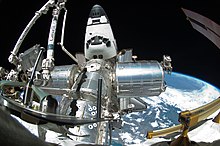






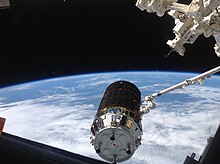
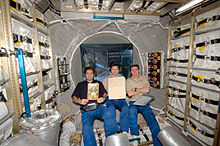
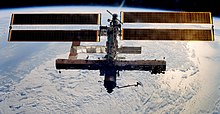



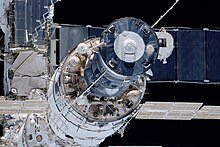
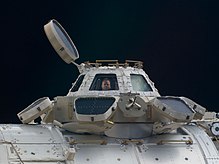



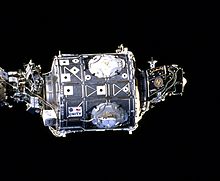



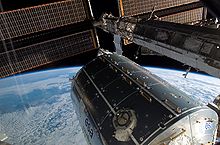











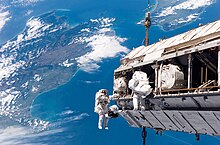










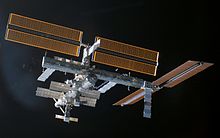
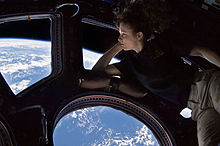





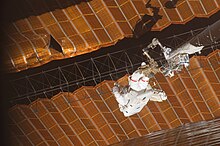
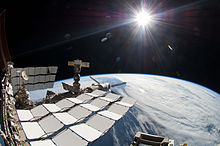



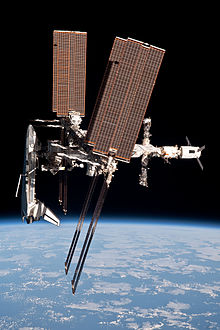

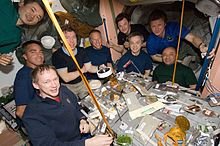


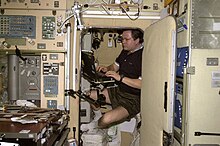




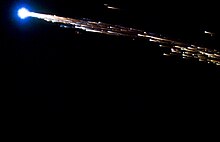




Keine Kommentare:
Kommentar veröffentlichen